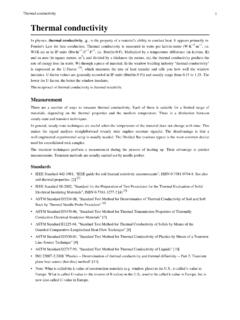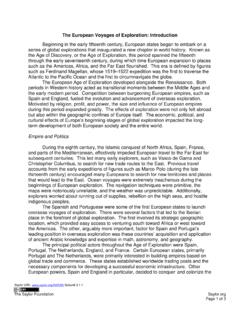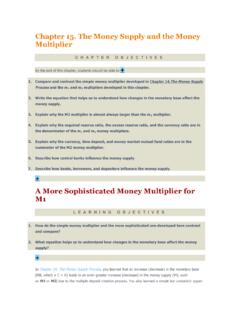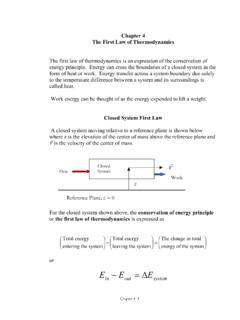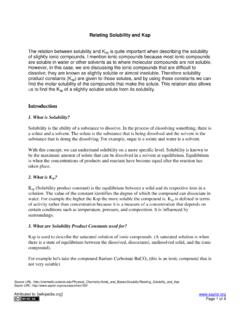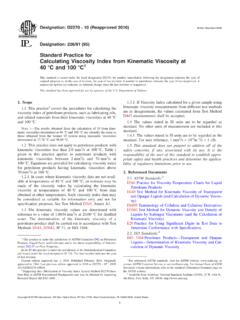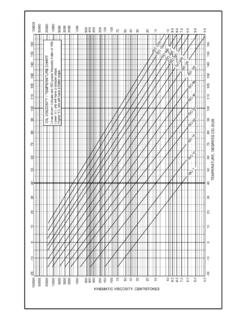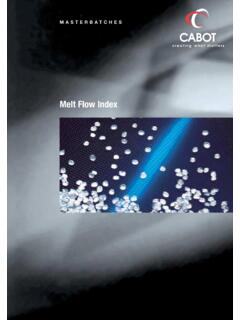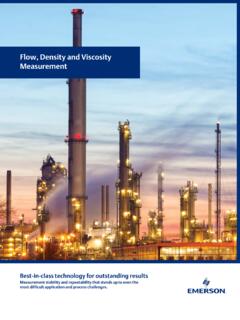Transcription of Viscosity - Saylor Academy
1 Viscosity1 ViscosityViscosityClear liquid above has lower Viscosity than the substance belowSI symbol: , SI unit:Pa s = kg/(s m)Derivations from other quantities: = G tViscosity is a measure of the resistance of a fluid which is being deformed by either shear stress or tensile stress. Ineveryday terms (and for fluids only), Viscosity is "thickness" or "internal friction". Thus, water is "thin", having alower Viscosity , while honey is "thick", having a higher Viscosity . Put simply, the less viscous the fluid is, the greaterits ease of movement (fluidity).[1] Viscosity describes a fluid's internal resistance to flow and may be thought of as a measure of fluid friction. Forexample, high- Viscosity felsic magma will create a tall, steep stratovolcano, because it cannot flow far before itcools, while low- Viscosity mafic lava will create a wide, shallow-sloped shield volcano. All real fluids (exceptsuperfluids) have some resistance to stress and therefore are viscous, but a fluid which has no resistance to shearstress is known as an ideal fluid or inviscid study of flowing matter is known as rheology, which includes Viscosity and related word " Viscosity " derives from the Latin word "viscum alba" for mistletoe.
2 A viscous glue called birdlime wasmade from mistletoe berries and used for lime-twigs to catch birds.[2]Properties and behaviorOverviewLaminar shear of fluid between two plates. Friction between the fluid and the movingboundaries causes the fluid to shear. The force required for this action is a measure ofthe fluid's Viscosity . This type of flow is known as a Couette general, in any flow, layers move atdifferent velocities and the fluid'sviscosity arises from the shear stressbetween the layers that ultimatelyopposes any applied relationship between the shearstress and the velocity gradient can beobtained by considering two platesclosely spaced at a distance y, andseparated by a homogeneous that the plates are very large,with a large area A, such that edgeeffects may be ignored, and that thelower plate is fixed, let a force F beapplied to the upper plate.
3 If this forcecauses the substance between the platesto undergo shear flow with a velocitygradient u (as opposed to just shearingelastically until the shear stress in the substance balances the applied force), the substance is called a applied force is proportional to the area and velocity gradient in the fluid and inversely proportional to thedistance between the plates. Combining these three relations results in the equation:Viscosity3 Laminar shear, the non-constant gradient, is a result of the geometry the fluid is flowingthrough ( a pipe).,where is the proportionality factor called equation can be expressed in terms of shear stress . Thus as expressed in differential form by IsaacNewton for straight, parallel and uniform flow, the shear stress between layers is proportional to the velocity gradientin the direction perpendicular to the layers:Hence, through this method, the relation between the shear stress and the velocity gradient can be that the rate of shear deformation is which can be also written as a shear velocity.
4 James Clerk Maxwell called Viscosity fugitive elasticity because of the analogy that elastic deformation opposesshear stress in solids, while in viscous fluids, shear stress is opposed by rate of of viscosityViscosity, the slope of each line, varies among materialsNewton's law of Viscosity , given above, is a constitutive equation (like Hooke's law, Fick's law, Ohm's law). It is nota fundamental law of nature but an approximation that holds in some materials and fails in others. Non-Newtonianfluids exhibit a more complicated relationship between shear stress and velocity gradient than simple linearity. Thusthere exist a number of forms of Viscosity : Newtonian: fluids, such as water and most gases which have a constant Viscosity . Shear thickening: Viscosity increases with the rate of shear. Shear thinning: Viscosity decreases with the rate of shear. Shear thinning liquids are very commonly, butmisleadingly, described as thixotropic. Thixotropic: materials which become less viscous over time when shaken, agitated, or otherwise stressed.
5 Rheopectic: materials which become more viscous over time when shaken, agitated, or otherwise stressed. A Bingham plastic is a material that behaves as a solid at low stresses but flows as a viscous fluid at highstresses. A magnetorheological fluid is a type of "smart fluid" which, when subjected to a magnetic field, greatlyincreases its apparent Viscosity , to the point of becoming a viscoelastic coefficientsViscosity coefficients can be defined in two ways: Dynamic Viscosity , also absolute Viscosity , the more usual one (typical units Pa s, Poise, P); Kinematic Viscosity is the dynamic Viscosity divided by the density (typical units m2/s, Stokes, St). Viscosity is a tensorial quantity that can be decomposed in different ways into two independent components. Themost usual decomposition yields the following Viscosity coefficients: Shear Viscosity , the most important one, often referred to as simply Viscosity , describing the reaction to appliedshear stress; simply put, it is the ratio between the pressure exerted on the surface of a fluid, in the lateral orhorizontal direction, to the change in velocity of the fluid as you move down in the fluid (this is what is referredto as a velocity gradient).
6 Volume Viscosity (also called bulk Viscosity or second Viscosity ) becomes important only for such effects wherefluid compressibility is essential. Examples would include shock waves and sound propagation. It appears in theStokes' law (sound attenuation) that describes propagation of sound in Newtonian , Extensional Viscosity , a linear combination of shear and bulk Viscosity , describes the reaction to elongation,widely used for characterizing polymers. For example, at room temperature, water has a dynamic shear viscosityof about 10 3 Pa s and motor oil of about 250 10 3 Pa s.[3] Viscosity measurementViscosity is measured with various types of viscometers and rheometers. A rheometer is used for those fluids whichcannot be defined by a single value of Viscosity and therefore require more parameters to be set and measured than isthe case for a viscometer. Close temperature control of the fluid is essential to accurate measurements, particularly inmaterials like lubricants, whose Viscosity can double with a change of only 5 some fluids, Viscosity is a constant over a wide range of shear rates (Newtonian fluids).
7 The fluids without aconstant Viscosity (non-Newtonian fluids) cannot be described by a single number. Non-Newtonian fluids exhibit avariety of different correlations between shear stress and shear of the most common instruments for measuring kinematic Viscosity is the glass capillary paint industries, Viscosity is commonly measured with a Zahn cup, in which the efflux time is determined andgiven to customers. The efflux time can also be converted to kinematic viscosities (centistokes, cSt) through theconversion used in paint, a Stormer viscometer uses load-based rotation in order to determine Viscosity . The Viscosity isreported in Krebs units (KU), which are unique to Stormer Ford Viscosity cup measures the rate of flow of a liquid. This, under ideal conditions, is proportional to thekinematic viscometers can also be used to measure Viscosity . These models such as the Dynatrol use vibration ratherthan rotation to measure Viscosity can be measured with various rheometers that apply extensional Viscosity can be measured with an acoustic Viscosity is a calculation derived from tests performed on drilling fluid used in oil or gas well calculations and tests help engineers develop and maintain the properties of the drilling fluid to thespecifications viscosityThe usual symbol for dynamic Viscosity used by mechanical and chemical engineers as well as fluid dynamicists is the Greek letter mu ( ).
8 [4] [5] [6] The symbol is also used by chemists, physicists, and the IUPAC.[7]The SI physical unit of dynamic Viscosity is the pascal-second (Pa s), (equivalent to N s/m2, or kg/(m s)). If a fluidwith a Viscosity of one Pa s is placed between two plates, and one plate is pushed sideways with a shear stress of onepascal, it moves a distance equal to the thickness of the layer between the plates in one cgs physical unit for dynamic Viscosity is the poise[8] (P), named after Jean Louis Marie Poiseuille. It is morecommonly expressed, particularly in ASTM standards, as centipoise (cP). Water at 20 C has a Viscosity of or kg/(m s).1 P = 1 g cm 1 s Pa s = 1 kg m 1 s 1 = 10 relation to the SI unit is1 P = Pa s,1 cP = 1 mPa s = Pa viscosityIn many situations, we are concerned with the ratio of the inertial force to the viscous force ( the Reynoldsnumber, ) , the former characterized by the fluid density.
9 This ratio is characterized by thekinematic Viscosity (Greek letter nu, ), defined as follows:The SI unit of is m2/s. The SI unit of is cgs physical unit for kinematic Viscosity is the stokes (St), named after George Gabriel Stokes. It is sometimesexpressed in terms of centiStokes (cSt). In usage, stoke is sometimes used as the singular St = 1 cm2 s 1 = 10 4 m2 s cSt = 1 mm2 s 1 = 10 6m2 s at 20 C has a kinematic Viscosity of about 1 kinematic Viscosity is sometimes referred to as diffusivity of momentum, because it has the same unit as and iscomparable to diffusivity of heat and diffusivity of mass. It is therefore used in dimensionless numbers whichcompare the ratio of the reciprocal of Viscosity is fluidity, usually symbolized by = 1 / or F = 1 / , depending on the conventionused, measured in reciprocal poise (cm s g 1), sometimes called the rhe. Fluidity is seldom used in concept of fluidity can be used to determine the Viscosity of an ideal solution.
10 For two components and ,the fluidity when a and b are mixed iswhich is only slightly simpler than the equivalent equation in terms of Viscosity :Viscosity7where a and b is the mole fraction of component a and b respectively, and a and b are the components unitsThe Reyn is a British unit of dynamic index is a measure for the change of kinematic Viscosity with temperature. It is used to characteriselubricating oil in the automotive one time the petroleum industry relied on measuring kinematic Viscosity by means of the Saybolt viscometer, andexpressing kinematic Viscosity in units of Saybolt Universal Seconds (SUS).[9] Other abbreviations such as SSU(Saybolt Seconds Universal) or SUV (Saybolt Universal Viscosity ) are sometimes used. Kinematic Viscosity incentistoke can be converted from SUS according to the arithmetic and the reference table provided in ASTM D2161.[10]Molecular originsPitch has a Viscosity approximately 230 billion( 1011) times that of water.


